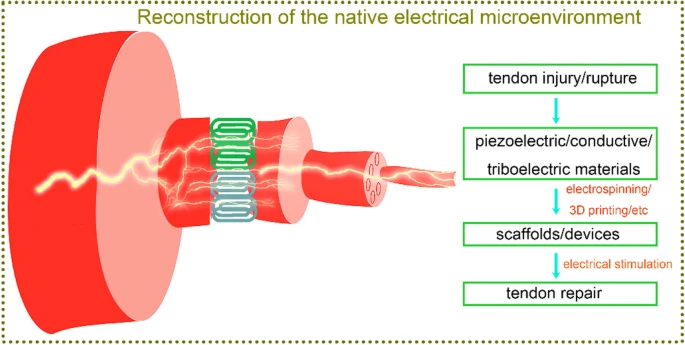
Abstract
Tendons are connective tissues with a regular three-dimensional structure containing collagen fibers, and the oriented collagen fibril gives tendons a piezoelectric effect. After tendon injury or rupture, the native electrical microenvironment in which it is located is disrupted, and the electrical signal pathway is blocked. Electrical stimulation (ES) can guide cell orientation, promote tissue differentiation, and enhance tendon repair. Therefore, bioactive materials that generate ES are ideal for repairing tendons by restoring the native electrical microenvironment. This review focuses on the application of piezoelectric materials, conductive materials, and triboelectric materials in tendon repair. They produce ES in different ways. Piezoelectric materials generate charges through deformation within the crystal under the action of force, which in turn causes the arranged dipole moments to deform, resulting in a net electric field. Conductive materials can generate a large number of freely moving charged particles under the action of an electric field and thus can conduct current. When two different triboelectric materials come into contact, opposite charges are formed on each surface, resulting in contact electrification. The materials are inextricably linked to each other, so the scaffold is developed that may be a single or multiple ES scaffold. For example, the mixed application of conductive material poly(3,4-ethylenedioxythiophene): poly(styrenesulfonate) (PEDOT: PSS) and piezoelectric material poly-L-lactic acid (PLLA), as well as the combined application of piezoelectric material polyvinylidene fluoride (PVDF) and triboelectric material nylon. More interestingly, PVDF is both a piezoelectric material and can generate charges under friction. Therefore, the development of high-performance cross-materials that can generate ES may be a better research direction in the future of tendon repair.
Highlights
-
Tendon exhibits a piezoelectric effect due to the directional arrangement of the collagen fibril.
-
Piezoelectric, conductive, and triboelectric biomaterials can generate electrical signals to repair tendon.
-
Long-term self-powered, flexible, wearable devices that integrate therapeutic and monitoring functions will be needed for tendon repair.


